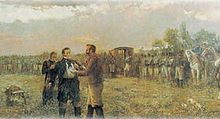Talk:Juan Manuel de Rosas/Initial conflicts
The Anarchy of the year XX
[edit]Buenos Aires was attacked in 1820 by provincial caudillos Estanislao López and Francisco Ramírez from the Entre Ríos and Santa Fe provinces, who rejected the centralism of the Argentine Constitution of 1819 and the inaction of Buenos Aires during the Luso-Brazilian invasion of the Banda Oriental. The constitution was repealed, the Congress of Tucumán was closed and the authority of the Supreme Directors ended. This period was known as "The Anarchy of the year XX".
Ramírez and López signed the Treaty of Pilar with Buenos Aires and returned to their provinces, but López renewed the attack. Juan Manuel de Rosas organized rural militias of 500 horsemen in support of the governor Manuel Dorrego, with an army of 2,000 men. They defeated López, but disagreed on the following action: Dorrego wanted to pursuit López into Santa Fe, and Rosas to secure the borders. Dorrego was defeated in the next battle. Rosas supported the appointment of Martín Rodríguez as governor of Buenos Aires, and mediated in the peace negotiations. López returned to Santa Fe in exchange of 25,000 cattle, that Rosas provided from his own ranchs. This led to the Treaty of Benegas between Santa Fe and Buenos Aires.[1]
The Decembrist revolution
[edit]
A new constituent assembly wrote a new constitution and appointed Bernardino Rivadavia as president of Argentina, but the constitution was rejected by the provinces and Rivadavia resigned. Vicente López y Planes was appointed interim president during the transition back to a confederated state; Rosas was appointed general commander of the militias of Buenos Aires during his brief rule. Manuel Dorrego was appointed governor again.[2]
Juan Lavalle, leading the troops that returned from the Cisplatine War, made a military coup against Dorrego. As it took place in December 1, 1828, it was known as the "Decembrist revolution". Dorrego and most federals left the city, joining the militias of Rosas. Rosas and Dorrego disagreed on the battle plan: Rosas wanted to move to Santa Fe, be reinforced by López and wait for the summoning of the people of the countryside; and Dorrego wanted to give battle immediately. They divided their forces, Dorrego was first defeated and then captured and executed. The execution generated a huge controversy in Buenos Aires, and Rosas and López defeaed Lavalle at the battle of Márquez Bridge, so he tried to negotiate peace.[3]
Lavalle visited Rosas' headquarters and negotiated the Cañuelas Pact with him. Juan José Viamonte was appointed interm governor with the support of both factions, and the legislature (closed during the revolution) was restored. This legislature appointed Rosas as the new governor, as well as giving him the rank of brigadier. But although the unitarians had been defeated in the Buenos Aires province, the Unitarian League was still a military threat from other provinces.[4]
References
[edit]Bibliography
[edit]- Luna, Félix (2004). Grandes protagonistas de la historia argentina: Juan Manuel de Rosas. Argentina: Grupo Editorial Planeta. ISBN 950-49-1251-6.
